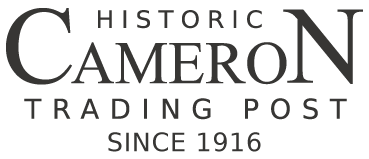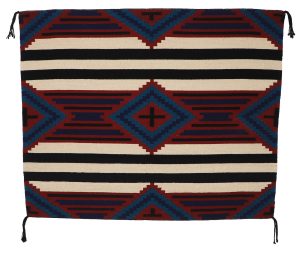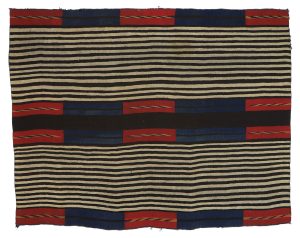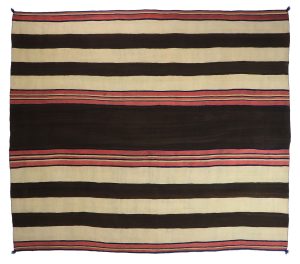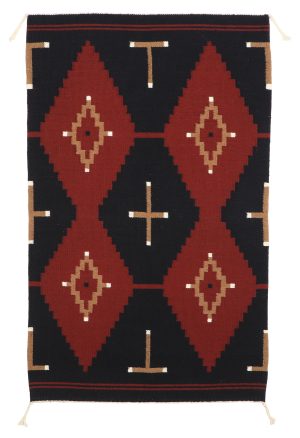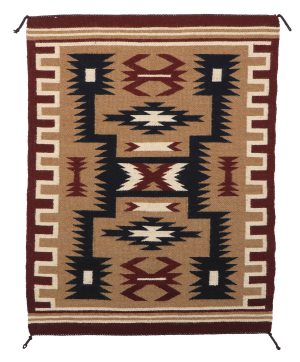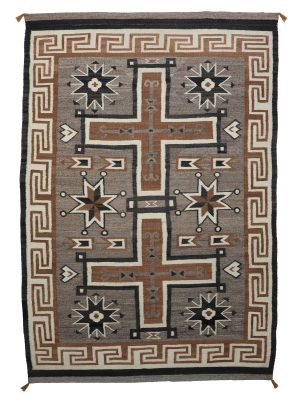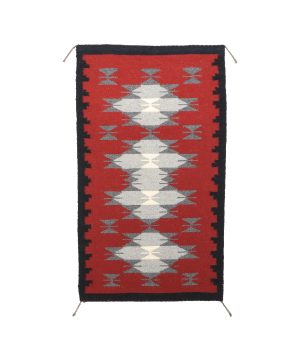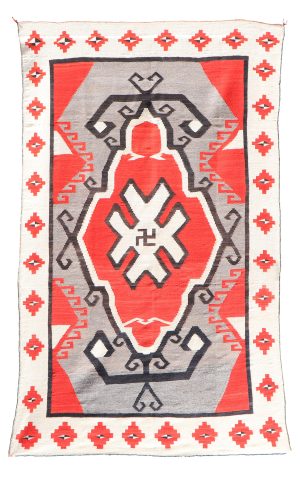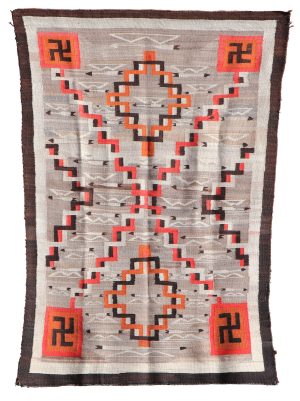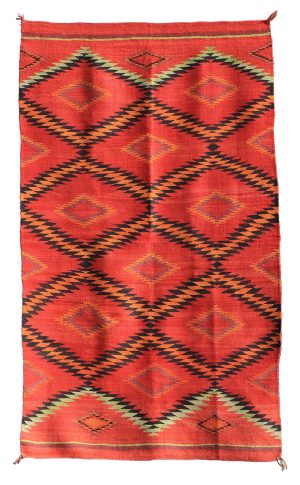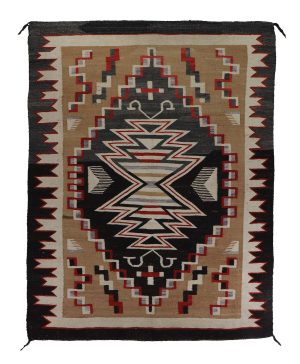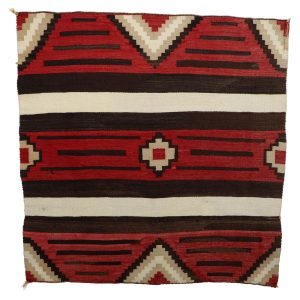Navajo Rugs
Shopping for authentic Navajo rugs and blankets online? Navajo rugs have held a special place and prominence at the Cameron Trading Post since it was established in 1916. Native American blankets, and later Native American Navajo rugs, have depicted beautiful art and historical/cultural/religious significance, and have always been an important part of the culture. The Navajo have traditionally woven the finest Navajo blankets and rugs and one doesn’t think of the Native American Indian art of Arizona without the image of the Navajo woven/Southwestern rug coming to mind.
Patterns in the Southwestern rugs seen today are historically based in the antique rugs of the past. The intricate designs and natural colors seen in a Navajo Southwestern area rug is a culmination of influences from the early trading posts, early Mexican colonists, and aspects of white American design culture, but all these the Navajo have incorporated and made into their own. Shop Navajo rugs for sale online at the historic Cameron Trading Post, or browse all other Native American art here.
Filters
Color
Color (Basic)
Flavor
Length
Ring Size
Size
Holster Side
Rug Size
Shop For
Stone
Tribe
Artist
Price
-
Navajo Chief Rug$1,950.00
-
Navajo Classic Second Phase Woman’s Blanket$39,500.00
-
Navajo Classic First Phase Blanket$485,000.00
-
Navajo Chief Rug$1,450.00
-
Navajo Storm Pattern Rug$1,100.00
-
Navajo Bisti Rug$6,500.00
-
Navajo Ganado Rug$695.00
-
Navajo Plate Rug$12,800.00
-
Navajo Pictorial Crystal Rug$4,950.00
-
Navajo Transitional Rug$5,850.00
-
Navajo Bisti Rug$2,800.00
-
Navajo Third Phase Revival Blanket$2,850.00
Authentic Navajo Rugs for Sale Online
The Navajo rugs for sale on our website are all authentic, handwoven by skilled Navajo weavers in the local area. At The Cameron Trading post, we have more than ten different types of Navajo rugs styles, from genuine antique rugs, to modern day, contemporary rugs.
Our Navajo rugs include Antique, Burntwater, Contemporary, Crystal, Ganado, Germantown, Pictorial, Storm Pattern, Teec Nos Pos, Two Grey Hills, Wide Ruins/Chinle, Yeis & Yei Be Chais, and other, unique designs which depict traditional woven techniques, symbolism, and religious significance.
Burntwater Navajo Rugs
Our Burntwater Navajo rugs were developed by Bruce Burhnam and Don Jacobs. Burntwater rugs are known for their pastel colors and native vegetal dyes. The designs are from Central Diamond and Four Sacred Mountain introduced from traders at the turn of the century.
Each one of these Navajo rugs have been handmade and weaved with articulation in mind. Burntwater rugs are most recent developments of the 1960’s that encouraged local weavers to create these beautiful designs. If you have any questions about our Burntwater rugs, the friendly staff at Cameron Trading Post is willing to help!
Navajo Pictorial Rugs
Our Navajo Pictorial rugs portray art of a variety of themes including religious ceremonies, scenes of daily life, and bird pictorials. Pictorial rugs began to show up as early as the 1860’s and are still used as an artistic expression in Native American culture today.
You will find an array of Navajo Pictorial rugs such tree of life, yei, and more. All our pictorial rugs are handwoven and true to the imagination of the weaver. If you have any questions about Navajo pictorial rugs, contact us today and we will be happy to answer any questions you may have, or you can browse our online selection.
Two Grey Hills Navajo Rugs
Another one of the most common types of Navajo rugs you’ll find are Two Gray Hills rugs. These rugs are commonly known for their exclusive use of natural wool colors such as browns and greys. They are known for great artistic quality because of the complicated designs and fine hand spinning that these weavers created.
Popular Two Gray Hills weavers are Daisy Tauglachee, Clara Sherman, and James Sherman. If you are looking for quality and artistic handwoven Navajo blankets, then browse through our Two Grey Hills collection today.
The History of Navajo Rugs
To better understand modern day Navajo rugs, we should talk a little bit about antique Navajo blankets and Navajo history overall. The Navajo people, among all the weavers of Native American blankets, have throughout history been considered the masters in weaving.
The history of these rugs is a long one that has threatened to end many times, and yet has still revived. Native American blankets, rugs and weavings of the Pueblos all suffered declines and revivals, but no Southwestern rug or blanket has ever rivaled the Native American blanket of the Navajo in popularity. Rugs were renowned items of Native American art throughout America even before the Revolutionary war!
Navajo Blankets Before 1900
Manufactured Southwestern rugs and Native American blanket designs began to replace true Native American Indian rugs and blankets around the turn of the century. Indeed, prior to 1900, it could be said that Native American Indians did not weave rugs, but wove blankets exclusively. The shift from Navajo blankets to rugs was necessitated by the times and facilitated by the traders. Because the native market for Native American blankets was disappearing, trading posts began to encourage Navajo rugs from the weavers; a heavier product than the Native American Blanket incorporating popular designs among Eastern tourists, No Indian trading post or Indian lodge was complete without a sprawling Southwestern area rug on the floor as part of its Southwestern décor.
Traders made sure that Easterners had access to rugs that could be displayed as an honest to goodness Native American Indian rug from the Wild West on the wall, or a real Southwestern area rug in the living room. Some enterprising traders began marketing their Southwestern area rugs in catalogs!
Navajo Blankets After 1900
Around the year 1900, the Navajo blanket transitioned to the Navajo rug and with each decade, this category of Southwestern rug has increased in beauty and technical excellence. Contemporary Southwestern rugs and antique blankets both have their own unique appeal to collectors of Native American Indian rugs. The Cameron Trading Post endeavors to offer the finest of both authentic rugs and blankets, and contemporary Southwestern area rugs for the collector.
Navajo Southwestern rugs today are woven in much the same way as their antique counterparts of the past. No pattern is used beyond that conceived in the weaver’s mind. The time once spent in shearing, carding, spinning, and dying the wool is often now regained in the use of pre-dyed wool that can be purchased in the trading posts. This yarn, after a few more spinnings, can be readily used, allowing the weaver to spend more time in the complexity and sublimity of her design. The time saved also makes many of today’s Navajo and Southwestern area rugs more affordable. However, the tradition of the Navajo shearing their own sheep and making their own yarn still exists.
A Note About Navajo Rug Regions
Native American Indian rugs today are categorized by design into Southwestern area rug regions. For example, Two Gray Hills are renowned for their fine weave of all natural wools. The Storm Pattern of Cameron’s regional Navajo rug is prized for its vibrant and powerful design symbolizing the beauty and fury of the storm.
Vegetal dyes, many discovered or recovered in the last 50 years, lend their soft and pleasing pastels to the rugs of Crystal and Chinle and Wide Ruins. J.L. Hubbell, Indian trader at Ganado did much to revive Navajo weaving at the turn of the century and many of the Navajo rugs from that region still display the dark “Ganado red” as popular today as it was then. You can appreciate and shop through our Ganado rug collection here.
Navajo Rugs FAQs
What are the 4 categories of Navajo rugs?
The four different categories of Navajo rugs are the Two Grey Hills rugs, Ganado rugs, Teec Nos Pos rugs, and Crystal rugs. These four categories are all characterized by specific weaving patterns which make them distinct. However, while artists will maintain the integrity of the tradition of the weaving, they may also blend and create a special design that makes that individual rug a unique piece.
What are Navajo rugs made out of?
While expensive, an authentic Navajo rug will always be crafted from high quality materials by an experienced artist. Navajo rugs sold by Cameron Trading Post are usually composed of sheep’s wool or cotton. Very few authentic rugs are crafted from synthetic yarn. An authentic rug will require many hours for the artist to sheer the sheep, spin the wool, prep and dye the wool, and weave the blanket.
How to identify Navajo rugs?
There are a number of identifiable styles of Navajo rugs. For instance, the Ganado rug is characterized by a red background with black, white, and gray designs encompassing one or two central diamonds, with geometric patterns woven into the edges of the rug. Two Gray Hills rugs have no colored dyes added, and are woven in white, brown, and black geometric patterns. Teec Nos Pos rug designs are vibrant, and have a wide border, complex geometric patterns, and a distinctive center design. Storm rugs have recognizable designs that represent the center of the universe with four smaller rectangles in its corners to represent the four sacred mountains of the Navajo people.
How can you tell if a Navajo rug is real?
If you’re a Native American art collector or enthusiast, we know that nothing is worse than a fake Navajo rug. The easiest way to determine if you have a fake Navajo rug on your hands is to examine the ends to see if the warps were tucked back in, or if they are truly continuous. If they are tucked in, then every other warp area will have two threads. Also, if the rug has fringe at both ends that are extensions of the warps, then it’s not an authentic Navajo rug. If you have questions about whether you have a real or fake Navajo rug on your hands, give us a call and we can help. (The rugs in our Navajo rugs category are all authentic, and we are always honest when an item is a reproduction vs a genuine piece.)
Why are Navajo rugs so expensive?
Genuine Navajo rugs are meticulously handmade using traditional techniques that have been passed down through many generations. Each rug can take weeks or even months to make, factoring the length of time that’s required to sheer the sheep, spin the wool, dye the wool, and perform the weaving process. In addition, the high quality wools that are used only add to the cost. Additionally, Navajo rugs are authentic works of art by Navajo artists that are often purchased by collectors, which drives up the price. At Cameron Trading Post, we understand that a genuine Navajo rug is a one-of-a-kind piece that deserves a price that represents the quality, time, and care that went into its making.
Navajo rugs, what are they worth?
As we’ve mentioned already, the cost of a Navajo rug will reflect whether it’s an antique or contemporary piece. Other factors include: the rug’s authenticity; condition; the meticulous shearing, weaving, and dying process; complexity of the design; weave’s tightness; dyes used, overall size; and lastly, the artist’s price. Some rugs are a few hundred dollars, while others are thousands of dollars. Prices on our website range from $300-$20,000 or more. See our items above for exact pricing, or contact us with questions.
How do you clean a Navajo rug?
Cleaning a Navajo rug requires delicate care to ensure that the rug is not damaged. Avoid machine washing, steam cleaning, or ironing. To remove any loose dirt or debris, you can use a dry vacuum cleaner with a smooth floor attachment on a low suction setting. Don’t use water. For an overall cleaning, you can use a foam rug cleaner for wool rugs.
Shop Navajo Rugs Online
The Cameron Trading Post has proudly sold many Navajo rugs since we first opened more than a century ago. Our rugs include Germantown, Teec Nos Pos, and Yeis & Yei Be Chais rugs. We also sell unique designs that don’t fit into a specific category of Navajo design.
Since we were first established in 1916, Cameron Trading Post has been committed to selling beautiful, historical, and genuine Native American art, pottery, baskets, sand paintings, fetishes, beauty products, clothing, décor, housewares, antiques, collectibles, and jewelry. You can rest assured that every Navajo rug we sell is authentic, and made meticulously by a skilled Navajo weaver. Shop Navajo rugs online today, or contact us with questions!
